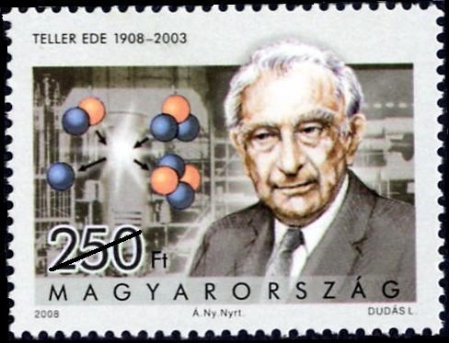CENTENARY OF THE BIRTH OF EDE TELLER
Date of issue: 3 November 2008
Ede Teller studied at the Technical University in Budapest and then in Germany, obtaining his PhD in physics in 1930. He obtained a post as a researcher in Göttingen, then joined the researchers around Heisenberg, Bohr and Einstein. After Hitler came to power he went to Denmark and then moved to the United States, later becoming an American citizen. In 1941 he became involved in the Manhattan plan, and took part in making the first atom bomb in Los Alamos, led by Oppenheimer. As early as 1940 Teller speculated whether the heat produced by a fission bomb could set off a larger thermonuclear reaction, the hydrogen bomb. When the Soviet Union exploded its first atom bomb, President Truman ordered the fusion weapon to be developed and in 1952 the first American hydrogen bomb was tested. The Hungarian Academy of Sciences elected Teller an honorary member in 1990. (Source: www.omikk.bme.hu)

The stamp design shows a portrait of Ede Teller with a sketch diagram of a fusion nuclear reaction in front of experimental equipment in the background. The first day cover shows the entrance of the school in Trefort Street in Budapest, where the physician studied between 1917-25. The postmark is a stylized drawing of nuclear fission.
Order code:
2008180010011/stamp
2008180060012/FDC
Perforated size: 40 x 30 mm
Number of copies: 200,000
Date of issue: 3 November 2008
Printed by Állami Nyomda
Face value: HUF 250
Designed by László Dudás

